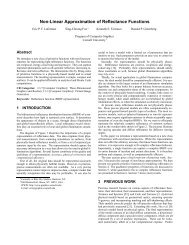pigmented colorants: dependence on media and time - Cornell ...
pigmented colorants: dependence on media and time - Cornell ...
pigmented colorants: dependence on media and time - Cornell ...
You also want an ePaper? Increase the reach of your titles
YUMPU automatically turns print PDFs into web optimized ePapers that Google loves.
light exposure. This effect is especially noticeable in the model’s left sleeve. The<br />
sequence of images shows a portrait exposed to increasing levels of accelerated<br />
illuminati<strong>on</strong>. Five c<strong>on</strong>centrati<strong>on</strong>s of Alizarin Crims<strong>on</strong> red were applied in glazes<br />
to depict the sleeves of the woman’s portrait. The scale <strong>on</strong> the left of each image<br />
corresp<strong>on</strong>ds to the five alizarin c<strong>on</strong>centrati<strong>on</strong>s used in the painting.<br />
The painting was exposed to light from a xen<strong>on</strong> lamp for a series of exposure<br />
<strong>time</strong>s. After each <strong>time</strong> period, the painting was removed for measurement of the<br />
c<strong>on</strong>centrati<strong>on</strong> of alizarin remaining in the glazes. The work was also photographed<br />
at each stage. The full exposure is approximately equivalent to a hundred years <strong>on</strong><br />
a museum wall well illuminated by diffuse daylight. While the images <strong>on</strong>ly reflect<br />
a subjective comparis<strong>on</strong> to the original paintings due to gamut restricti<strong>on</strong>s, the<br />
changes in the deteriorati<strong>on</strong> of the Alizarin Crims<strong>on</strong> are readily seen.<br />
The reflectances of the five c<strong>on</strong>centrati<strong>on</strong>s of Alizarin Crims<strong>on</strong> were measured<br />
<strong>and</strong> c<strong>on</strong>verted to the Munsell color space. The changes in each glaze can be seen<br />
in Figure 4.18 as the plot describes each hue (for paint samples 1-5) in respect<br />
to their Munsell chroma <strong>and</strong> value. The Munsell coordinates for each original<br />
paint are plotted as white dots <strong>and</strong> the exposed sample reflectances as black dots.<br />
Each original paint sample is grouped with its corresp<strong>on</strong>ding samples of increasing<br />
exposure via a blue ellipse.<br />
As expected, the exposed sample reflectances grew further from each original<br />
sample as <strong>time</strong> passed. The Munsell value increased <strong>on</strong> all samples over <strong>time</strong> (the<br />
equivalent of the hue growing closer to white). The chroma is more complicated,<br />
however. The initially darker glazes (denoted 1,2, <strong>and</strong> 3 <strong>on</strong> the graph), increased in<br />
chroma as the fading proceeded (the maximum chroma was achieved by the middle<br />
122<br />
c<strong>on</strong>centrati<strong>on</strong> (3)). In c<strong>on</strong>trast, the lighter glazes (4 <strong>and</strong> 5) decreased in chroma



